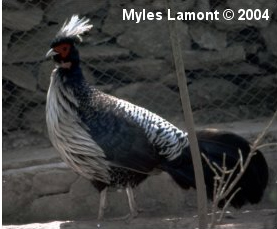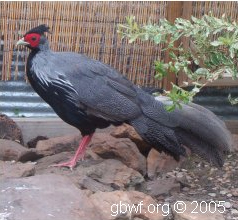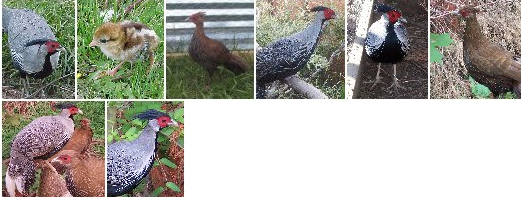 Subspecies & Range: Nine were recognized by Delacour, but two races L. l. lineata andL. l. crawfurdi, are sometimes considered races of the Silver Pheasant L. nycthemera.
Subspecies & Range: Nine were recognized by Delacour, but two races L. l. lineata andL. l. crawfurdi, are sometimes considered races of the Silver Pheasant L. nycthemera.
White-crested Kalij (L. l. hamiltoni), western Himalayas to extreme western Nepal; Nepal Kalij (L. l. leucomelanos), endemic to Nepal; Black-backed Kalij (L. l. melanota), northwest India and western Bhutan; Black Kalij (L. l. moffitti), range uncertain, believed to be central Bhutan; Black-breasted or Horsfield’s Kalij (L. l. lathami), eastern Bhutan and northeastern India east to Burma (Myanmar); William’s Kalij (L. l. williamsi), western Burma; Oates’ Kalij (L. l. oatesi), southern Burma; Lineated Kalij (L. l. lineata), eastern Burma, northwestern Thailand; Crawfurd’s Kalij (L. l. crawfurdi), southeastern Burma, southwestern Thailand.
Habitat: Varied; from mountainous forests to lowland cultivated lands and forests, depending on race.
Description: Considerable variation between the races; western Kalij (sometime known as the Blue or Himalayan Kalij in captivity) tend to be overall dark blue. The eastern Kalij, also known as the Grey Kalij, have more vermiculations and barring, much like Silver Pheasants. (see taxonomy notes below).
Of the subspecies that are kept in captivity, the White-crested Kalij L. l. hamiltoni is perhaps the most common. It is the only subspecies with a light crest. Native to the western Himalayas from the Indus River east to western Nepal, where it possibly intergrades with the Nepal Kalij. Their status in the wild seems secure and are considered to be quite common in northwest India. White-crested Kalij frequent elevations up to 11,000 feet in evergreen and decidous forests.
Male: Long and rather thin crest of disentegrated white or pale grayish brown feathers falling on the nape; head and neck purplish black; mantle glossy bluish black, the feathers with pale grey edges and a white shaft; feathers of middle and lower back, rump and lesser tail coverts black with an indistinct narrow suberterminal brown line and a broad terminal white fringe 5mm wide; tail black, brownish at tips; primaries and secondaries blackish brown; chin and throat brownish black; breast and sides of body covered with long, lanceolate feathers dark brownish grey at the base, light grey to whitish at the tip; those of the flanks and abdomen are broader, dark grey with pale edges and a white shaft. There is much variation in the color of the crest and of the breast feathers. Iris brown to orange; face wattles scarlet, with tiny black featherlets; bill greenish white, more or less tinged with blackish at the base and on culmen; legs pale brown to grey. Length: 650-730 mm.; wing: 225-250 mm.; culmen: 23-30 mm.; tarsus: 75-80 mm.
Female: Long crest dull brown with pale shafts; body plumage pale brown, inconspicuously vermiculated with blackish, each feather with a pale shaft and a light grey border which is missing in the flight feathers; two or four central rectrices brown vermiculated and streaked with black and buff; the others blackish with pale tips; belly paler. There is a good deal of individual variation in the depth and shade of the brown. Soft parts as in the male, but browner. Length: 500-600 mm.; wing: 203-215 mm. tail: 205-215 mm.; culmen: 20-25 mm.; tarsus: 65-70 mm.
Immature: Dark brown, the head more rufous; ear-coverts blackish; upper plumage freckled with black, each feather with a subterminal black and a terminal rufous buff border; under parts lighter with a terminal whitish spot.
Downy Chick: Head and upper back chestnut with a dark line from eye to nape as in all species of the genus; upper parts dark brown with two broad lateral whitish buff bands; under parts whitish, wing mottled brown and buff; legs reddish flesh.
The Nepal Kalij L. l. leucomelanos replaces the White-crested in central Nepal. Inhabits similar mountainous forested habitats from 4,000 to 6,000 feet. Has been introduced and is now established in the Hawaiian Islands. Nepal Kalij are often seen in captivity, but they are not as popular with many due to their rather drab plumage. In the wild, the populations are stable and not threatened.
Males can be distingushed from hamiltoni in having a dark and slightly shorter crest. I’ve seen and talked with others that there is a good deal of variation among captive males (this raises the validity of pure stock in America), but according to Delacour, the white fringed feathers of the lower back and rump are more narrow than hamiltoni; also on the mantle, there should be little or no gray edging to the feathers. Hens can be tough to distinguish from hamiltoni, they are generally darker and the gray borders of the feathers more noticeable. If you are raising both White-crested and Nepal, please be sure to band or mark the birds to keep lines separate. I’ve once puchased a young so-called Nepal pair in the past, only to see the crest turn light as the male grew older.
The Black-breasted Kalij L. l. lathami is also known as the Horsfield’s Kalij, this subspecies is seen in a few American aviaries. They are found in evergreen and deciduous forests in eastern Bhutan and northeastern India east to Burma. Has the largest range of the kalij and is still considered common in the wild. Much overall darker than the two mentioned with no lanceolated markings on the breast and underparts; the only barring is found on the rump; the crest is much more upright in stance as well. Hens are also darker than the mentioned races with only faint barring.
It is very doubtful that there are any pure Black-backed Kalij L. l. melanota or Black Kalij L. l. moffitti left in American aviaries. It has been many years since these birds were last imported and any that are attempted to be passed as these races are more than likely hybrids. melanota resemble leucomelanos, overall darker and males lack the white fringe on the rump, but do have a pale gray breast; hens are dark brown wuth light borders to the feathers and a white throat; the crest of both sexes are much shorter than the mentioned. moffitti is entirely black, dark back like melanota and dark breast like lathami; hens are much like melanota, but the throat is buff. Two other races, William’s Kalij L. l. williamsi and Oates’ L. i. oatesi have never been kept in captivity in the US (not sure about collections overseas). williamsi resemble lathami, but much more vermiculated and appear gray overall.
 The two Grey Kalij races consist of the Lineated Kalij L. l. lineata males with very fine vermiculations of black and white on upperparts that give gray apperance with white streaked feathers on the side of the breast; the crest, chin, breast and belly is black; tail long with central feathers buffy-white. Hens are brown above with a dark brown crest, the breast and abdomen with white v-shaped streaks that are bordered with black; both sexes have brownish to gray legs. Crawfurd’s Kalij L. l. crawfurdi resemble lineata, but legs are reddish and the vermiculations of the back and sides wider and coarser, tail is shorter; hens are darker with very dark, almost black underparts, white v-like streaks wider and bolder.
The two Grey Kalij races consist of the Lineated Kalij L. l. lineata males with very fine vermiculations of black and white on upperparts that give gray apperance with white streaked feathers on the side of the breast; the crest, chin, breast and belly is black; tail long with central feathers buffy-white. Hens are brown above with a dark brown crest, the breast and abdomen with white v-shaped streaks that are bordered with black; both sexes have brownish to gray legs. Crawfurd’s Kalij L. l. crawfurdi resemble lineata, but legs are reddish and the vermiculations of the back and sides wider and coarser, tail is shorter; hens are darker with very dark, almost black underparts, white v-like streaks wider and bolder.
Status in Wild: As a species, they are considered safe and unthreatened. The races in the west are common in most areas, the eastern races are considered vulnerable.
Taxonomy Data: Sometimes placed in the genus Gennaeus. Species name sometimes spelled leucomelana. L. l. lathami sometimes known as L. l. horsfeldii. Recent DNA work published in the Ibis, notes that two races (lineata & crawfurdi) should belong with leucomelanos instead of nycthemera. Click here to view the article in PDF format. If new data becomes available for nycthemera and leucomelanos, I will be sure to include it on this site.
Breeding Season: As with most species, it vaires with climate. They seem to be among the last species to begin laying (Missouri) for me. The Horsfield’s would start the in the middle of May, Nepal and White-crested in early June.
Breeding Age: Males will attain their adult plumage their first year and are often fertile at this age as well. First year hens will lay and are sometimes fertile.
Clutch Size: 6-9 eggs.
Incubation Period: Captive birds average about 22-23 days. In the wild, the races in the cooler areas incubate for 22 days and 20 days in the warmer areas. Should be encouraged to allow the hens to set, they are great mothers.



